February 2020
Monthly Archive
February 29, 2020
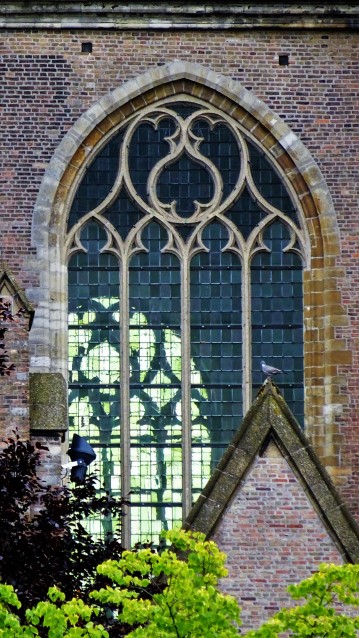 This is the fourth window in my Lenten series of forty essays. I’ve been photographing windows for decades, but this Lenten practice finds me looking at/through them in new ways.
This is the fourth window in my Lenten series of forty essays. I’ve been photographing windows for decades, but this Lenten practice finds me looking at/through them in new ways.
As was the case yesterday, there is one more window here than first meets the eye. Photographing a church in Dordrecht, I was taken by the shapes and textures of this image, and only discovered much later the bird perched on the foreground peak.
So, yes, there’s a clear-glassed church window, but notice the other window on the opposite side of the church. Through the nearer window we see through to the other side. Thus, a theme for today, not so much the architecture, but the idea of there being another side.
When a friend suffers from a serious illness or a dire disease, when someone’s livelihood disrupted, or when some challenge seems insurmountable — to be human, fully human, is to “get through it to the other side.” It’s the proverbial “light at the end of the tunnel.” Or, survival. Or, victory. Healing. Redemption. A new beginning. All of those.
The first thing to realise is that there is “the other side.” This is not as simplistic as Annie singing, “The sun will come out tomorrow, tomorrow…” (though I may be guilty of that innocence in yesterday’s entry). No, this recognition is a profound and heart-inspired, even gnawing, hope.
I like what the playwright and author Jean Kerr wrote:
Hope is the feeling you have that the feeling you have isn’t permanent.
Frederick Buechner compares hope with wishful thinking.
Sometimes wishing is the wings the truth comes true on. Sometimes the truth is what sets us wishing for it.
The Apostle Paul pointed out (in 1 Corinthians 13) that of faith, hope, and love, hope comes in only second or third. But if it is the love of life that pushes us beyond its lack, I imagine it is hope that feeds the faith that gets us to “the other side.”
Some other very human traits help us in the struggle. You can order them yourself; no need to debate the chronology. Patience. Persistence. Will. Imagination and its life-partner Creativity. Oh, and Desire, as in, “I just want to get through this!”
[I must admit that some things “on the other side” are beyond all wishing, all effort. For that, there is grace…and Easter.]
Still, I look at today’s photo and see again that bird. Imagine the small creature looking through the nearest window to the further one and seeing that inviting light and wondering — (do birds wonder? I said, “Imagine…”) — How do I get there?
Simple answer: use your wings.
Or, mine.
February 28, 2020
Posted by celebrationrock under
agape love,
darkness,
easter,
Lent,
Lenten reflections,
Light of the World,
photography,
psalms,
rain,
shadows,
spirituality,
Uncategorized,
windows
1 Comment
This is another in a series of essays about various window views I’ve photographed. It’s Lent, and this is my 40 day writing discipline for what it’s worth. 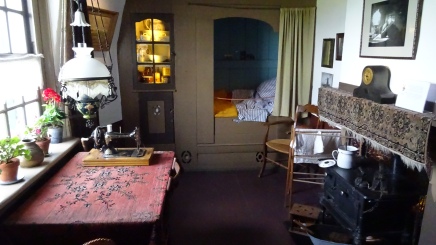
This photo was taken in a rather unusual place. We could call this a multi-purpose room; it seems to serve as a living room, sewing room, and dining room, with a built-in bedroom, presumably for a small child.
We walked through this room while visiting The Netherlands. This is part of the living quarters of a windmill in Kinderdijk. I chose this image because it has two windows, one letting in light from outside, enough light to brightly illuminate the whole room. And the other, an interior window serving as a cupboard door, protecting the contents, but allowing one to see what is stored there: everyday items, commonly used, not special things on display, but just out of the way. (I suspect the light was added for the tours, and wouldn’t have been there for the actual residents.)
But note the large window on the left. My wife Joan has her sewing/quilting machine right by a window too. The natural light that pours through shows the fabrics in their true colors, and keeps the stitches true. The light from the outside is white, indicating that this might have been a cloudy day. But even overcast, the room is bright. That’ll preach, as they say. Even though a day seems dismal, or a season dark, the sun rises every morning and eventually breaks through. It always has and always will.
(The story goes that Mark Twain was leaving church with a friend when it began to rain heavily. His friend casually asked Twain, “Do you think it will stop?” Twain replied, “It always has.”)
So, there’s Lent. I ask church folk if they are having a miserable Lent. When they cast a puzzled look, I say that a good Lenten word is the Latin miserere. Mercy, lament. The theme of Psalm 51 which begins, “Have mercy on me, O God…” In the Presbyterian Book of Common Worship that Psalm is followed by a prayer which begins, “God of mercy, you know us better than we know ourselves, and still you love us.” (Italics added here for emphasis.)
Here’s a surprise, even for me! I looked at the windmill window image more closely and discovered a third window! Check out this detail from a picture on the wall. 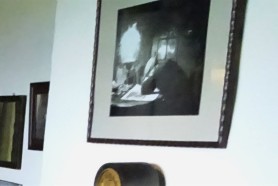 A bowed figure, a lamp, and a window with light either reflecting the lamp or letting light in from outside. The person there appears to be weary. Or, in prayer? Or, bereft? In need of, and dependent on, light. As are we all.
A bowed figure, a lamp, and a window with light either reflecting the lamp or letting light in from outside. The person there appears to be weary. Or, in prayer? Or, bereft? In need of, and dependent on, light. As are we all.
“…And still you love us.” That is the promise of Lenten light. And the Light at the end of these forty days is Easter. On the way, we strive to keep our colors and stitches true!
February 27, 2020
Each Lenten season I write daily for this blog called “Peace, Grace, and Jazz.” It’s a Lenten practice that I enjoy, challenging myself first to just keep at it (for forty days!), and then to write about something, well, creative — choosing words that spring from a theme I want to explore on the way to Easter. This year: windows.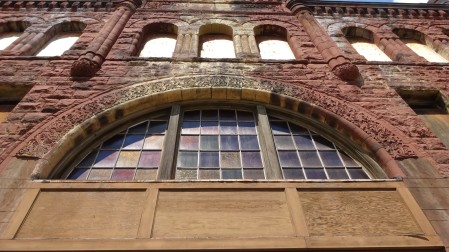
Even if you live near Binghamton, NY, you may not recognize these windows, though they’ve been letting light through the front of this building since 1892. Local historian Roger Luther describes the architecture this way: “With elements of Richardsonian Romanesque style, the distinctive façade was of rough-hewn and carved red sandstone.” Curiously, he used the past tense. Frankly, the façade is still of those elements, since the building remains standing…barely.
The larger arched window(s) appear to be of stained glass of some sort. But perhaps they are just filthy. Dust and debris fill the building. Decades of city grime from without and cigarette smoke from within can coat window glass until sunlight can hardly break through. And yet. The various subtle colors of each pane, pastels of blue, rose, and cream, suggest that the windows serve an artistic function and are indeed stained glass.
Is that a church? An old government office building? While a derelict now, it was once a grand opera house. And then a movie palace. I can only guess that the prominent window over the entrance was designed to cast a warm glow into an ornate hallway or upper lobby area. Clear glass would have exposed the patrons inside to the reality of the cityscape outside, and the light shining into the theater, whether sunlight or streetlight, would have broken the spell of the escape one sought in opera, film, or the grandness of the structure itself.
Stained glass, frosted glass, glass bricks…all allowed some light in, but blocked clear vision for one reason or another. These days when we think of “stained glass” we probably think of churches. Many houses of worship have glorious works of art in arched windows (and I’ll be sharing many examples in this space as Lent progresses), but even some modest storefront churches have applied translucent colored plastic sheets to what were once display windows for merchandise, simulating the colored glass effect.
In thinking about the old opera house window pictured here and the windows of church sanctuaries, I ran across this quotation from the 19th century preacher and abolitionist Henry Ward Beecher.
The clearest window that ever was fashioned, if it is barred by spiders’ webs, and hung over with carcasses of insects, so that the sunlight has forgotten to find its way through, of what use can it be? Now, the church is God’s window; and if it is so obscured by errors that its light is darkness, how great is that darkness!
I’m thinking that Lent might be a good time to wash some windows. Scrub the clear glass clean so we can see clearly the landscape of celebration and need outside in neighborhood and world, and so that sunlight can pour into our homes to brighten our living spaces, even in the shadows of Lent. And, if we are in cathedrals blessed with magnificent stained glass art, some cleaning and polishing will make the windows’ stories and symbols more clear to us, as the spectrum of jewel-like colors bathes the worship space with beauty and grace. And Easter’s glory.
Lent is a time to consider errors of the heart, yes, the dinginess that blocks the Light of the World. We’ve got some cleanup to do. And forty days to do it in.
February 26, 2020
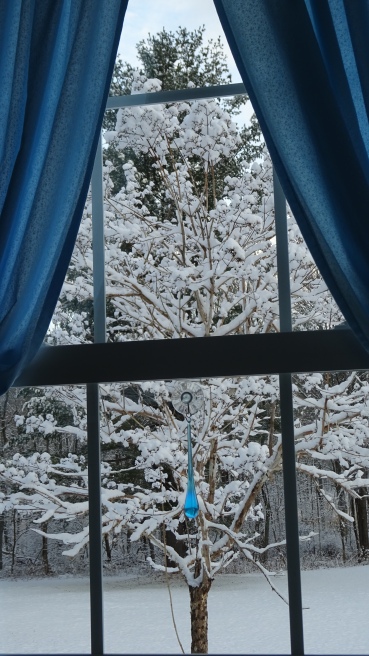
For the past several years, I’ve used Lent’s forty days as a time to write. Making entries in a blog isn’t one of the original Lenten disciplines, but along with prayer, fasting, giving alms, and reading scripture, the practice of daily writing may involve all of those others.
Some writing is prayerful. Sharing thoughts may be more helpful than tossing coins into a Lenten-themed receptacle of some sort. Perhaps “fasting” needn’t be limited to “giving up” food or M&Ms, but could involve carving out an hour of an otherwise busy day to reflect on a spiritual prompt that comes from meditating on scripture. See? I’m good at rationalizing this venture.
Several years ago, I wrote of forty people whose lives gave strength to my spirit. Then there was that quirky essay-fest when I wrote of (and photographed) forty mugs from the Kellam kitchen shelves. Actually, I rather enjoyed that exercise, as did a couple of readers who got a smile out of the daily writings if not deep inspiration.
Last year, my intention was to write of the music (pop, classical, sacred, all kinds) that added to the tempo and rhythm of my life and ministry. But…Lent was interrupted by a Panama Canal cruise. And with no affordable internet on the ship, the discipline was shattered. Still, we bought a nice souvenir in Colombia: a wood carving of a nativity scene. (Not exactly a Lenten item, but…)
All this brings me to this year’s theme. In my travels and with my local photographic eye, windows often draw my focus. Stained glass, yes, of course. But also those ordinary windows that let light pour into our rooms while letting us look out onto the local landscape of yard or city street. The window pictured here is the view from my bed as I awaken. Obviously, it is winter. Cold. Even frigid, perhaps. But beautiful. That tree just outside the window is a marvel. It takes on a different personality with each season, as many trees do. But this one “blooms” three times a year, and with different colors. And the bark is always peeling. Marvelously odd. My bed, the window, the tree. And me. Reason to get up in the morning.
So, each day I’ll post a photo of a window. I have no plan. I’ll just look through my photo files and when I see a window of some kind, I’ll think about what it might say to me, and then I’ll write. Maybe my words will be less than inspiring; the pictures will be worth a look though.
Oh, and just for the heck of it, I looked up the word “window” in a Biblical concordance. Guess what? There are some windows mentioned in the Bible. Who knew?
 This is the fourth window in my Lenten series of forty essays. I’ve been photographing windows for decades, but this Lenten practice finds me looking at/through them in new ways.
This is the fourth window in my Lenten series of forty essays. I’ve been photographing windows for decades, but this Lenten practice finds me looking at/through them in new ways.
 A bowed figure, a lamp, and a window with light either reflecting the lamp or letting light in from outside. The person there appears to be weary. Or, in prayer? Or, bereft? In need of, and dependent on, light. As are we all.
A bowed figure, a lamp, and a window with light either reflecting the lamp or letting light in from outside. The person there appears to be weary. Or, in prayer? Or, bereft? In need of, and dependent on, light. As are we all.
